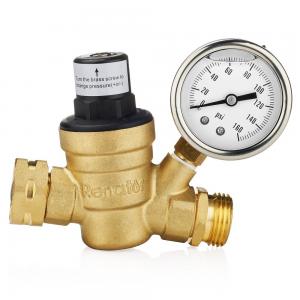
Add to Cart
Low Pressure Oxygen Concentrator Parts Water Adjustable Brass Pressure Adjust Valve
1. description
A valve is a device that regulates, directs or controls the flow of a fluid (gases, liquids, fluidized solids, or slurries) by opening, closing, or partially obstructing various passageways. Valves are technically fittings, but are usually discussed as a separate category. In an open valve, fluid flows in a direction from higher pressure to lower pressure. The word is derived from the Latin valva, the moving part of a door, in turn from volvere, to turn, roll.
The simplest, and very ancient, valve is simply a freely hinged flap which drops to obstruct fluid (gas or liquid) flow in one direction, but is pushed open by flow in the opposite direction. This is called a check valve, as it prevents or "checks" the flow in one direction. Modern control valves may regulate pressure or flow downstream and operate on sophisticated automation systems.
Valves have many uses, including controlling water for irrigation, industrial uses for controlling processes, residential uses such as on/off and pressure control to dish and clothes washers and taps in the home. Even aerosols have a tiny valve built in. Valves are also used in the military and transport sectors.
2. components
Body
The valve's body is the outer casing of most or all of the valve that contains the internal parts or trim. The bonnet is the part of the encasing through which the stem (see below) passes and that forms a guide and seal for the stem. The bonnet typically screws into or is bolted to the valve body.
Valve bodies are usually metallic or plastic. Brass, bronze, gunmetal, cast iron, steel, alloy steels and stainless steels are very common.Seawater applications, like desalination plants, often use duplex valves, as well as super duplex valves, due to their corrosion resistant properties, particularly against warm seawater. Alloy 20 valves are typically used in sulphuric acid plants, whilst monel valves are used in hydrofluoric acid (HF Acid) plants. Hastelloy valves are often used in high temperature applications, such as nuclear plants, whilst inconel valves are often used in hydrogen applications. Plastic bodies are used for relatively low pressures and temperatures. PVC, PP, PVDF and glass-reinforced nylon are common plastics used for valve bodies
Bonnet
A bonnet acts as a cover on the valve body. It is commonly semi-permanently screwed into the valve body or bolted onto it. During manufacture of the valve, the internal parts are put into the body and then the bonnet is attached to hold everything together inside. To access internal parts of a valve, a user would take off the bonnet, usually for maintenance. Many valves do not have bonnets; for example, plug valves usually do not have bonnets. Many ball valves do not have bonnets since the valve body is put together in a different style, such as being screwed together at the middle of the valve body.
Ports
Ports are passages that allow fluid to pass through the valve. Ports are obstructed by the valve member or disc to control flow. Valves most commonly have 2 ports, but may have as many as 20. The valve is almost always connected at its ports to pipes or other components. Connection methods include threadings, compression fittings, glue, cement, flanges, or welding.
Handle or actuator
A handle is used to manually control a valve from outside the valve body. Automatically controlled valves often do not have handles, but some may have a handle (or something similar) anyway to manually override automatic control, such as a stop-check valve. An actuator is a mechanism or device to automatically or remotely control a valve from outside the body. Some valves have neither handle nor actuator because they automatically control themselves from inside; for example, check valves and relief valves may have neither.
| Item | pressure adjust valve |
| Pressure | medium pressure |
| Application | general |
| Nominal pressure | 1.6mpa |
| Working medium | water,steam |
| Material | brass |
| Size | DN15 |
| Power | manual |
